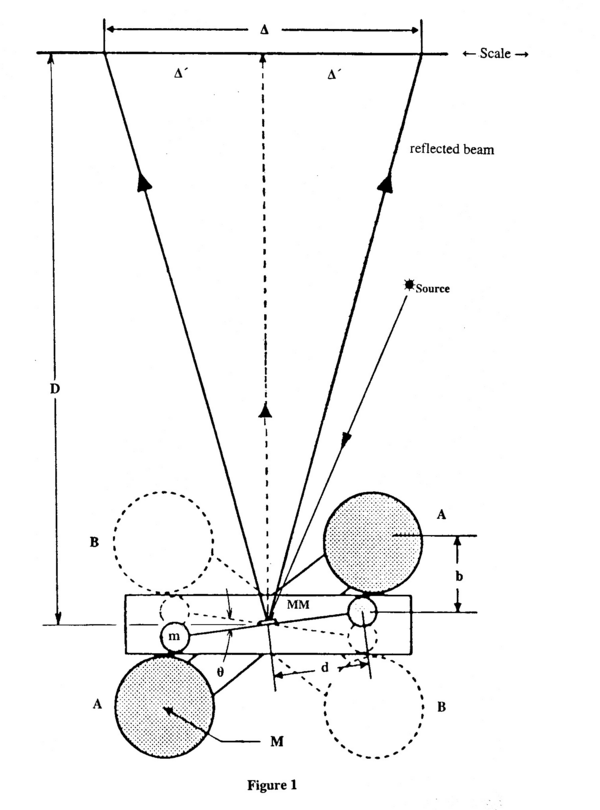Difference between revisions of "Main Page/Cavendish"
m (Protected "Main Page/Cavendish" ([edit=sysop] (indefinite) [move=sysop] (indefinite))) |
|
(No difference)
| |
Revision as of 12:03, 18 July 2011
Measurement of the Gravitational Constant G with a Torsion Balance: The Cavendish Experiment
Introduction
Cavendish first performed the measurement of G, one of the classic experiments in physics, in 1798. The apparatus at your disposal is a modified form of that used by Cavendish and others. The high sensitivity of the apparatus demands patience, perseverance and care from the experimenter. This is a very delicate instrument so treat it gently.
A lamp S (see Fig. 1) illuminates a small (effectively) massless mirror MM that is attached to a light horizontal rod holding two small lead balls of mass m at a separation of 10cm. The small balls and mirror are suspended from a 25cm. bronze torsion wire (perpendicular to the page). The entire apparatus is enclosed in a rigid case that is mounted securely on a wall or table.
When two massive lead balls (each with mass M = 1.5kg) are placed asymmetrically as illustrated, in position AA, a small torque acts on the torsion balance twisting the torsion wire and causing the image of the light source to swing through a measurable distance Δ' along the opposite wall. The swing gradually decays until equilibrium is reached. The massive balls are next placed at diametrically opposite points, BB, for further measurement. After the oscillations have died away once more, a second equilibrium position is reached at a distance Δ' with respect to the other side of the zero position. We will use this pattern to evaluate a value for G, the gravitational constant.
|
Figure 1 - Experiment Setup (Top View)
|
Method
IMPORTANT: Treat the equipment gently. For example, slamming the door or bumping into the table will considerably lengthen the experimental observation time.
In order for the balance to operate correctly, the torsion wire must be precisely vertical and must be able to move freely. The centres of the four balls must lie in one plane as well.
Both a manual recording technique and the chart recorder method are used in this experiment. The position of the light beam on the scale on the opposite wall is noted when the heavy balls are an equal distance from the small balls. The large balls are then rotated so that they almost touch the case. You should make this adjustment carefully to ensure that the heavy balls do not knock the case. If the case is accidentally knocked, the mirror will be set into a large amplitude oscillation that will take about 1 hour to decay. You can therefore save yourself a lot of time (and effort) by making this adjustment delicately in the first place.
If this step has been completed successfully the position of the light spot on the opposite wall will change slowly with time. Note this position on the scale (a cross wire) every 15 seconds for the first few minutes and every 30 sec. or 1 min. thereafter. The light spot will undergo damped oscillations about an equilibrium position Δ'. Determine the mean period of oscillation P with a stop watch and compare this with the value derived from a plot of displacement vs. time. Allow about 45 min – 60 minfor these oscillations to damp out and measure the new equilibrium position x1 (see Fig. 2).
